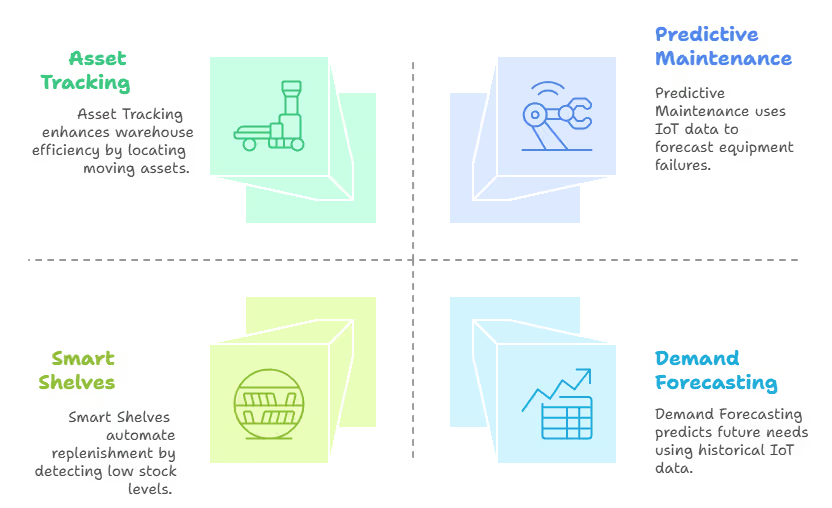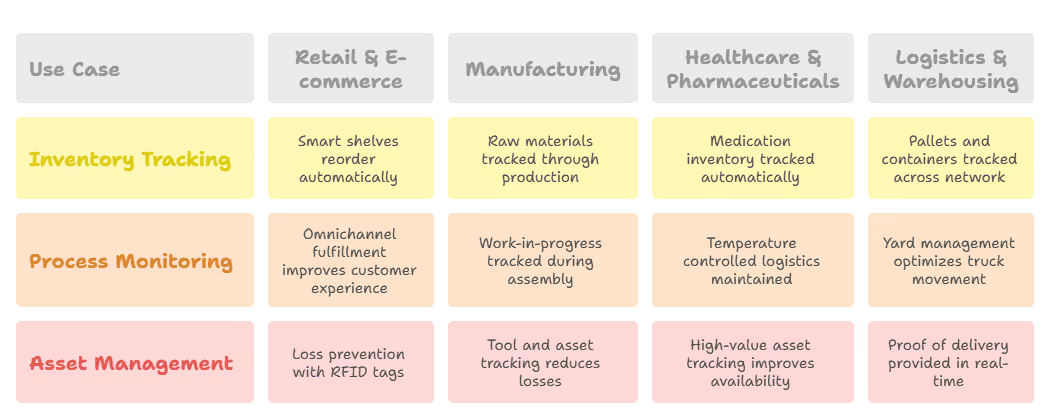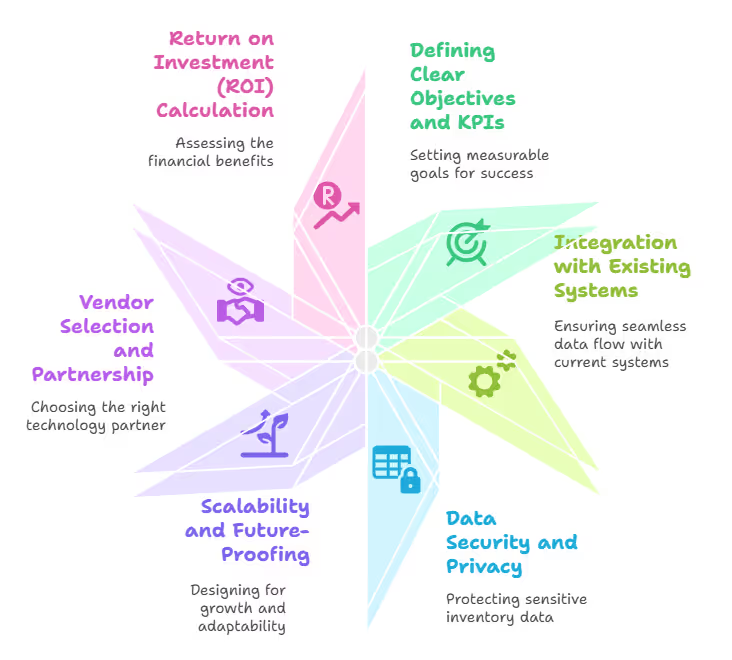IoT for Inventory Management Solutions in USA

In today’s fast-paced US supply chain and retail environment, manual inventory tracking is no longer enough. Businesses need accurate, real-time data to reduce losses and meet customer demand efficiently. That’s where IoT for inventory management comes in, leveraging smart sensors, RFID tags, and connected platforms to monitor stock, automate replenishment, and streamline warehouse operations. This technology isn’t just for large enterprises; even small and mid-sized businesses in the USA are adopting IoT to stay competitive.
IoT for inventory management uses connected devices, RFID tags, and sensors to provide real-time visibility of stock levels, locations, and movement. For US businesses, it improves accuracy, reduces manual errors, lowers costs, and optimizes supply chains by automating inventory tracking and replenishment.
Table of Contents
- Why Traditional Inventory Management Fails in Modern Supply Chains
- How is IoT Used in Inventory Management? A Deep Dive into Connected Operations
- Use Cases of IoT in Inventory Management Across US Industries
- Real-World Impact: Personal Experiences and Industry Examples
- Key Considerations for US Decision-Makers: Implementing IoT Inventory Management
- Comparison of IoT Technologies for Inventory Management
The Core Problem: Why Traditional Inventory Management Fails in Modern Supply Chains
We must first understand the limits of old inventory management methods.
Many US businesses still rely on manual processes, separate systems, or old barcode scanning.
This causes many problems:
- Inaccurate Stock Counts: Mistakes happen with manual data entry or infrequent checks. This leads to either no stock or too much stock. According to a study by the National Retail Federation, inventory distortion (shrinkage and overstocks) cost US retailers $61.7 billion in 2022.
- Lack of Real-time Visibility: People often make decisions based on old data, not what's happening now. This means you can't quickly react to changes in demand or unexpected problems like port traffic jams or bad weather in the USA.
- Inefficient Replenishment: Without exact data on how much product people use, ordering more becomes slow and wasteful. This leads to higher costs for holding too much stock and lost sales when you don't have enough.
- High Labor Costs: Tracking and counting by hand takes a lot of people. This takes valuable staff away from more important tasks.
- Limited Traceability: In industries like medicine or food, tracking products from where they are made to the shelf is vital for rules and safety. Old methods struggle with this.
These problems are even bigger for large businesses and spread-out networks common across the United States.
Goods might travel thousands of miles and go through many hands.
This is exactly where how is IoT used in inventory management provides a strong answer.
How is IoT Used in Inventory Management? A Deep Dive into Connected Operations
Putting IoT in stock management means using a network of connected devices.
These include sensors, RFID tags, smart cameras, and gateways.
- Collect and send data about inventory in real-time.
- The data is processed and analyzed to give useful information.
- Automates a process that was once done by hand and full of errors.

Real-time Inventory Tracking and Monitoring
One of the biggest and fastest ways IoT in inventory management helps is by letting you track assets and products right now.
- RFID (Radio-Frequency Identification) Tags: These small, cheap tags attach to individual items, pallets, or containers. RFID readers in warehouses, on forklifts, or at loading docks can scan hundreds of tags at once. This gives instant updates on how much stock you have and where it is. For example, a big car parts seller in Michigan might use RFID to track thousands of engine parts. This ensures correct counts and stops them from getting lost in their huge buildings. This is a key part of good iot inventory tracking.
- Barcode Scanners & Vision Systems: Modern barcode systems often connect to IoT platforms. Advanced vision systems, using AI and connected cameras, can find and count items without people. This is very helpful in places with many items or for strange shapes.
- GPS and Geofencing: For goods being moved, GPS trackers show their location right now. Geofencing can send alerts when inventory enters or leaves certain areas. This is vital for managing goods moving between factories in the Midwest and distribution centers on the coasts.
- Sensor-based Monitoring: Beyond location, sensors can check environmental conditions important for delicate inventory. Temperature and humidity sensors are crucial for keeping cold chains safe (like medicines in California, fresh food in Florida). They make sure products stay good and follow rules. Accelerometers can tell if fragile goods got rough handling during travel.
Automated Inventory Replenishment (Smart Shelves & Bins)
Imagine shelves that tell you they need refilling, or bins that order parts by themselves.
This is what inventory management using IoT promises.
- Weight Sensors: Smart shelves with weight sensors can tell when stock levels drop too low. This works well for small, fast-moving items in stores or on factory lines. When the stock reaches a certain low point, the system can automatically send an order. It tells suppliers or the buying team. A top electronics maker in Texas might use this for key parts on their assembly line. This keeps production going without manual checks.
- Infrared and Optical Sensors: These sensors count items as people take them off or put them on shelves. They give an exact, real-time count without needing manual scanning.
- Bin Level Sensors: For bulk materials or parts in bins, ultrasonic or laser sensors measure how full they are. This ensures raw materials are refilled on time for production. This ability is very valuable for continuous production businesses like chemical making in Louisiana. This directly helps with proactive iot inventory replenishment.
Optimized Warehouse Operations
IoT does more than just tracking and counting.
It makes the whole warehouse work better.
- Asset Tracking: Beyond inventory, IoT can track moving things like forklifts, pallet jacks, and even tools in a warehouse. This means they get used better, people spend less time looking for them, and maintenance gets scheduled well.
- Predictive Maintenance: Sensors on warehouse machines can watch how they perform (vibration, temperature, power use). This helps predict when they might break down. Then, you can fix them before they cause expensive stops. This keeps downtime low and goods moving smoothly.
- Workforce Optimization: It's not just about inventory. Understanding traffic patterns and problem spots using IoT sensor data can help make warehouse layouts better and worker paths more efficient. This leads to faster picking and packing.
Demand Forecasting and Analytics
The huge amount of real-time data from IoT devices gives a great base for advanced analysis and better demand guessing.
- Historical Data & Real-time Consumption: By mixing old sales data with current usage patterns from IoT, businesses can guess future demand much more accurately. This helps set the right safety stock levels and avoids expensive overstocking or running out of items.
- Predictive Analytics: AI and machine learning programs can look at IoT data to find trends, guess future demand, and even see possible problems in the supply chain. This lets you make changes before issues happen. For a big food seller across the USA, this means making the best use of fresh food and cutting down on waste a lot.
Use Cases of IoT in Inventory Management Across US Industries
IoT in inventory management is very flexible. Its uses are wide, helping many different industries.
Each industry gets unique benefits.

Retail & E-commerce
- Smart Retail Shelves: These shelves automatically order more items, making sure popular products are always there. This directly makes customers happier and boosts sales. Imagine a big clothing chain across the United States using this to keep their most popular sizes and colors always available in every store.
- Loss Prevention: RFID tags can also set off alarms if items leave the store without being bought. This greatly reduces theft.
- Omnichannel Fulfillment: Knowing inventory in real-time lets stores fill orders easily from any place, store, warehouse, or distribution center. This makes the customer experience better and is more efficient.
Manufacturing
- Raw Material Tracking: From the moment raw materials arrive at a factory in Detroit or Pittsburgh, IoT sensors can track them through the production line. This ensures the right materials are ready at the right time for each step of making things.
- Work-in-Progress (WIP) Tracking: Watching parts as they go through different assembly steps gives a clear picture of how production is going and spots problems. This helps keep production schedules running well.
- Tool and Asset Management: Tracking expensive tools and equipment inside a factory means fewer losses, better use, and easier maintenance.
Healthcare & Pharmaceuticals
- High-Value Asset Tracking: Hospitals and clinics across the USA can use IoT to track expensive medical equipment (like IV pumps, ventilators). This makes sure they are available when needed, improving patient care and how well operations run.
- Temperature-Controlled Logistics (Cold Chain): For vaccines, blood, and other medicines sensitive to temperature, IoT sensors ensure strict temperature rules are followed throughout the supply chain. This goes from the maker to the pharmacy. This is vital for following rules and making sure products work.
- Inventory of Medications and Supplies: Counting medicines in hospital pharmacies automatically saves human effort and ensures critical drugs are always in stock.
Logistics & Warehousing
- Pallet and Container Tracking: Big logistics companies handling huge networks across the United States use IoT to track thousands of pallets and containers. This ensures correct routes and on-time delivery.
- Yard Management: Making the movement and parking of trucks and trailers in large shipping yards better. This cuts down on jams and makes loading/unloading more efficient.
- Proof of Delivery: IoT can connect with other systems to give real-time proof of delivery. This makes billing more accurate and customers happier.
Real-World Impact: Personal Experiences and Industry Examples
I've seen firsthand how IoT changes inventory operations for the better.
My work with clients shows this clearly.
Boosting Accuracy for Electronics Distributors
- The Challenge: A large electronics distributor in Silicon Valley, California, lost money quarterly from misplaced high-value parts. They also lacked real-time visibility into their massive warehouse.
- The Solution: We installed an RFID-based tracking system for critical components, linking it with their existing warehouse management software.
- The Results:
- Inventory accuracy jumped from 85% to over 99% within six months.
- Misplaced items almost disappeared.
- Time spent on manual inventory counts dropped by 70%.
- Real-time data let their buying team optimize orders, cutting holding costs by 15%.
- This showed the immense value that iot in stock management delivers, empowering smarter, faster decisions.
Saving Perishables for Produce Suppliers
- The Challenge: A fresh produce supplier in Florida faced significant losses from spoilage. This happened due to unpredictable travel times and insufficient temperature monitoring for their perishable goods.
- The Solution: We deployed a system using IoT inventory tracking with temperature and humidity sensors inside their refrigerated trucks and storage facilities.
- The Results:
- The system constantly sent data, immediately alerting them to any temperature changes.
- This active approach reduced spoilage by over 20%.
- It greatly improved their compliance with food safety regulations.
- Decision-makers, initially doubtful, became strong supporters after seeing the direct positive impact on their finances and product quality.
- Adding iot inventory replenishment capabilities further sharpened operations, leading to less waste and more efficient deliveries.
Key Considerations for US Decision-Makers: Implementing IoT Inventory Management
For CEOs and CTOs in the USA thinking about an IoT project for inventory, they must think about several key things.
These help ensure the project works well and gives the best return on investment.

Defining Clear Objectives and KPIs
Before you spend money, clearly state what success looks like.
Do you want to:
- Cut stockouts by X%?
- Make inventory accuracy Y% better?
- Lower carrying costs by Z%?
- Make order fulfillment A minutes faster?
Clear Key Performance Indicators (KPIs) will guide your project and let you see the results.
Integration with Existing Systems
An IoT inventory management system rarely works alone. It must connect smoothly with your current ERP (Enterprise Resource Planning), WMS (Warehouse Management System), and TMS (Transportation Management System).
- API-driven Solutions: Choose solutions that have strong APIs (Application Programming Interfaces) for easy data sharing.
- Data Standards: Make sure data formats are compatible. This avoids expensive custom work or problems translating data. For example, if your current WMS uses specific SKU formats, the IoT system must work with them.
Data Security and Privacy
Because inventory data and operational details are sensitive, strong cybersecurity is most important.
- Encryption: All data, both when moving and when stored, should be encrypted.
- Access Controls: Put in strict rules for who can access what data. This ensures only authorized people can see or change information.
- Compliance: For industries like healthcare (HIPAA) or defense, make sure your IoT solution follows relevant US federal and state rules.
Scalability and Future-Proofing
Your IoT solution should be able to grow with your business.
- Modular Design: Choose a design that lets you add more sensors, devices, or features as your needs change.
- Cloud Agility: Cloud-based IoT platforms offer flexibility and can grow with you. This lets you expand operations across many warehouses or regions without big upfront hardware costs. Big cloud providers like AWS, Microsoft Azure, and Google Cloud offer strong IoT services for businesses in the USA.
Vendor Selection and Partnership
Picking the right technology partner is vital.
Look for vendors who have:
- Proven Track Record: Experience in your specific industry and location (e.g., successful projects with US manufacturers or retailers).
- Comprehensive Support: From setting up at the start to ongoing maintenance and fixing problems.
- Technological Prowess: Expertise in the right IoT technologies (RFID, sensors, analytics, cloud).
Return on Investment (ROI) Calculation
Create a clear ROI model that includes both direct and indirect benefits.
- Direct Benefits: Lower labor costs, fewer inventory write-offs, lower holding costs.
- Indirect Benefits: Happier customers, better operations, improved decision-making.
Comparison of IoT Technologies for Inventory Management
Next Steps: The Imperative of Connected Inventory in the USA
Supply chain management in the USA is changing fast. Consumer demands, global complexities, and the constant push for efficiency drive this. For CEOs and CTOs who make big decisions, ignoring what IoT in inventory management can do is no longer an option. IoT offers strong ways to solve modern logistics problems.
It cuts down on expensive mistakes, optimizes stock levels, and gives you a clear, real-time view like never before.
As an IoT engineer, I've seen companies that use these technologies not only make their operations smoother but also gain a big advantage over others. Moving from reacting to problems to actively managing inventory, powered by smart data, is a key step. It helps build supply chains that are strong, flexible, and cost-effective.
Are you ready to change your inventory operations and make your business more competitive?
Talk to an IoT solutions expert today. They can discuss how these technologies can fit your specific needs and help your business grow in the fast-moving US market.


